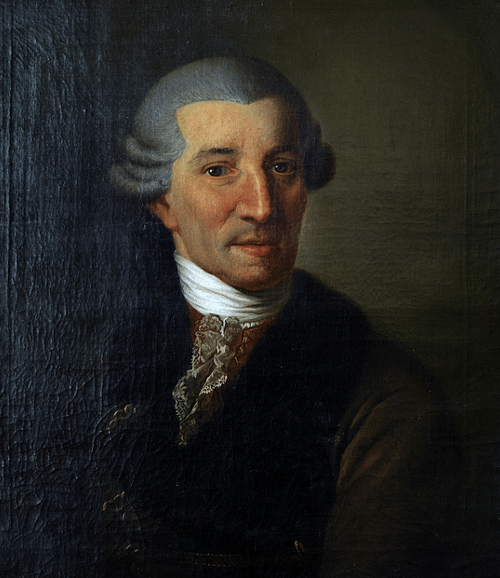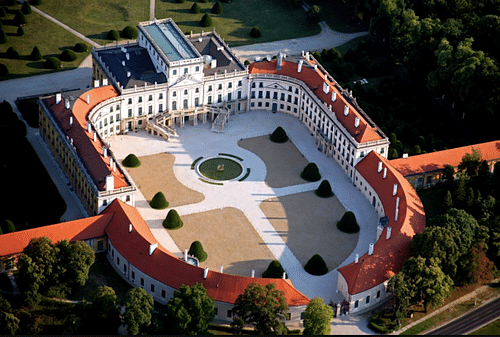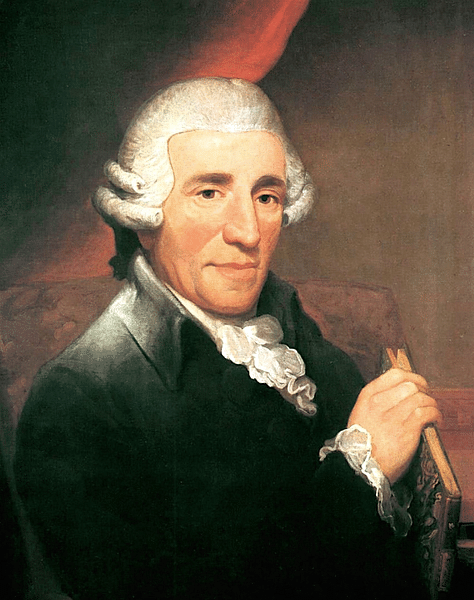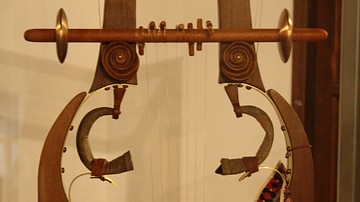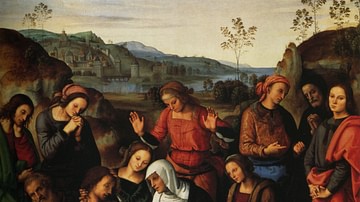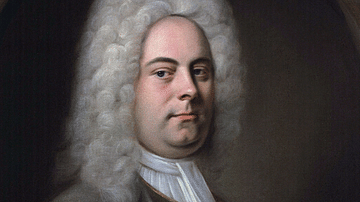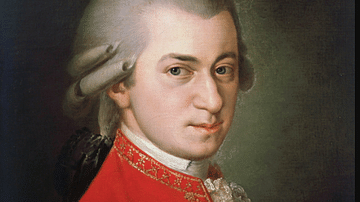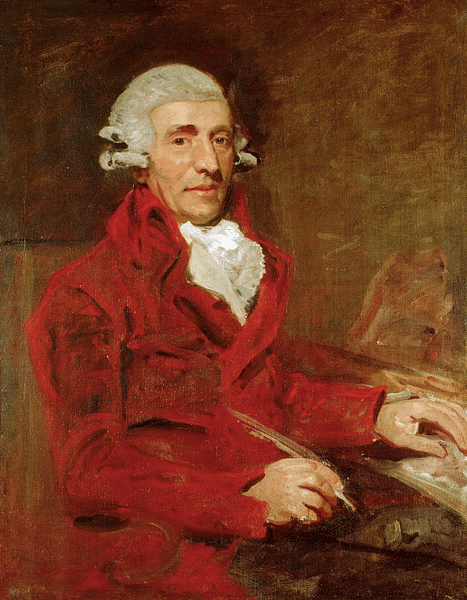
Joseph Haydn (1732-1809) was an Austrian composer of Classical music who is widely regarded as one of the greatest composers in history. Haydn spent most of his career around Vienna, where he pioneered the symphony and string quartet format, which became standard forms of Classical music. Haydn enjoyed a high international reputation during his own lifetime, with his work being performed across Europe.
Early Life
Franz Joseph Haydn (he dropped the Franz in early life) was born on 31 March 1732 in the village of Rohrau, Lower Austria. His father, Mathias, was a master wheelwright, and Joseph was one of 12 offspring (two of them became professional musicians besides Joseph). The size of the family and his parents' humble status perhaps explain Haydn's comment later in life that his childhood witnessed "more floggings than food" (Schonberg, 75).
Mathias played the harp to accompany the singing of Anna, Joseph's mother. Joseph showed early promise in music, and after a couple of years of private lessons and thanks to the praise of his local parish priest, he was enrolled in the choir of St. Stephen's Cathedral in Vienna when he was eight years old. This role included a musical education. He learnt to play the harpsichord and violin and some music theory, although Haydn himself later said that, in this period, he "listened more than I studied" (Wade-Matthews, 323). The young Haydn seems to have had a sense of fun that often went too far. In 1749, he was dismissed from the choir after he cut off the pigtail of the boy in front of him in the choir stalls (although not insignificantly, his voice had recently broken, too). Haydn had already learnt enough to make a living as a music teacher, adding to his rather low income whenever possible with occasional performances at private parties.
The historian H. C. Schonberg gives the following summary of Haydn's physique and character:
He was short and dark, his face was pitted by smallpox, his legs were too short for his body. His nose had a polyp that threw it out of shape, and he appears to have been sensitive about it…A person of singularly sweet, kind disposition, he made virtually no enemies at any time. He was even-tempered, industrious, generous, had a good sense of humour, handled his love affairs like a gentleman…He may not have been well educated, he was not much of a reader, but he was practical and with good common sense. He had integrity and intellectual honesty…He liked to dress well. (73)
Haydn admired the music of George Frideric Handel (1685-1759), and he began to compose. Another influence was Nicola Porpora (1686-1768), the Italian composer of opera. Haydn worked for Porpora – "cleaning shoes, beating his coat and arranging his antique periwig" (Steen, 108) – and, in return, was taught composition. As his reputation grew, the public performances of Haydn's work occurred in more aristocratic surroundings. A performance at the home of Baron von Fürnberg led to employment by Count Morzin in Bohemia in 1757. Haydn worked for Morzin until the count went bankrupt in 1761. Fortunately for the composer, he walked right into a plum job at one of Central Europe's greatest households.
Life at Eisenstadt
Haydn was employed at the court of the Hungarian Counts Esterházy from 1761 to 1790. The current count, Paul II Anton, Prince Esterházy (l. 1711-1762), resided in the family castle at Eisenstadt, located some 48 kilometres (30 mi) from Vienna. It was the prince who had heard an early symphony of Haydn's, and he decided to employ him. In this period, musicians and composers were treated no differently from other senior servants. Haydn had to wear the prince's livery and eat and sleep with the other (higher-ranked) servants, but at least he lived in comfort. Eventually, Haydn managed to get his own house in the nearby village. He had plenty of occasions to show off his talent, but there was the caveat that all works composed by him contractually belonged to his employer.
Haydn had a choir and a well-equipped orchestra at his disposal, and he was free to be original in his music. There was the downside that Haydn had to "compose such pieces as his Serene Highness may command" (Sadie, 178), and he was not permitted to compose music for anyone besides the prince. Haydn was first appointed the vice-Kapellmeister before becoming the Kapellmeister in 1766. The role meant he not only composed and conducted the orchestra of around 23 players but also hired and fired the musicians, looked after all the instruments, and maintained a library of scores. Haydn had to compose or conduct major musical performances at least four times a week, but he did have sufficient time off to pursue his other interests of shooting and fishing.
Things really took off musically for Haydn when Prince Paul Anton died in 1762 and his brother took over. Nikolaus I, Prince Esterházy 'the Magnificent' (l. 1714-1790), was determined to be known for his hospitality and entertainment, first at Eisenstadt and then at his magnificent purpose-built 'summer palace', Eszterháza, located on the edge of Lake Neusiedl on the Austro-Hungarian border, some 24 kilometres (15 mi) from Eisenstadt. Eszterháza became the most magnificent palace in Europe besides that of the French monarchs at Versailles. Haydn was expected to come up with exciting new music to be played in the prince's new concert hall, ballroom, and impressive theatre. He also had to compose works the prince could play on his baryton, a large stringed instrument played like the cello.
Haydn still resided at Eisenstadt, which became rather neglected as the prince spent more time at Lake Neusiedl. The musicians at the older palace were also feeling a little neglected, and so they conspired with Haydn to show their dissatisfaction with their patron. In November 1772, Haydn composed a new symphony suggestively called the Farewell Symphony. When it was performed, the finale involved all the musicians leaving the stage but doing so one by one until only two violinists remained to carry the tune. In 1779, Haydn was able to renegotiate his contract and have the exclusivity clause eliminated, a change he fully exploited by taking commissions from home and abroad. He also now lived, when required, in a cottage in the park of Eszterháza.
Relationships
Haydn's marriage came about rather bizarrely. He had fallen in love with a girl, Therese Keller, the daughter of a wigmaker and one of Haydn's pupils, but she joined a nunnery. Haydn then married her older sister, Maria Anna Keller, in 1760. It was not a happy marriage. Maria took no interest in music, and their two temperaments clashed, Maria being bad-tempered and Haydn easy-going. The composer conducted several affairs and had at least one special friend, Marianne von Genzinger, a doctor's wife.
Wolfgang Amadeus Mozart (1756-1791) was particularly influenced by the music of Haydn, whom he met in person in 1783. Mozart learnt structure from the older man, while Haydn learnt to become more expressive in his music thanks to Mozart's influence. Mozart and Haydn often played music together and took an interest in each other's works in progress throughout their careers. In 1785, Mozart dedicated six of his own string quartets to Haydn; today they are known as the 'Haydn' quartets. The respect was mutual, as Haydn once said to Mozart's father, "Before God, and as an honest man, I tell you that your son is the greatest composer known to me" (Arnold, 1209).

In 1792-3, a young Ludwig van Beethoven (1770-1827) was sent to study under Haydn in Vienna. The music of both Mozart and Haydn influenced Beethoven in the first stage of his career as a composer. Haydn did not get on with Ludwig, but he certainly recognised his talent, once stating that "Beethoven will in time fill the position of one of Europe's greatest composers" (Schonberg, 74). The quartet of Haydn, Mozart, Beethoven, and Franz Schubert (1797-1828) became known as the First Vienna School.
Symphonies, Sting Quartets, & Sonatas
Incredibly, Haydn composed over 100 symphonies. He perfected the symphony form, which would become standard in Classical music. The symphony was then made up of four movements: a fast opening, a slow and lyrical second, a shorter dance third, and a fourth which usually presents a fast and dramatic finale. In the 1770s, Haydn's symphonies reflected what became the "fashionable literary-influenced style known as Sturm und Drang ("storm and stress"). Many are in unusual keys, and exhibit a wide variety of moods" (Wade-Matthews, 325). A striking trilogy of symphonies is Times of Day, composed in 1761. These works allow most of the players in the orchestra to shine in a short solo part. The 'Mourning' Symphony was composed in 1771 with the intention it would be played at Haydn's own funeral. Haydn (and Beethoven) were primarily responsible for creating what became the norm for a Classical symphony orchestra, that is around 40 players.
Haydn pioneered the use of the string quartet, for which he wrote over 70 pieces. Traditionally, any small group of musicians had almost always included a harpsichord player. The new string quartet may have evolved for playing music outdoors, for example, at garden parties, where a harpsichord was impractical. The string quartet of Haydn was composed of two violins, one viola, and one cello, with each player given an equal opportunity to play. The composer made the music of string quartets more serious with four movements and music that carried a theme and was highly expressive, unlike the traditional approach to such music, which tended to emphasise entertainment. The 'Sun' Quartets (Op. 20) were "revolutionary in manner, with strong thematic integration, counterpoint to make the instrumental parts of equal importance, fast scherzos instead of elegant minuets, and fugal finales" (Arnold, 846).
A series of innovative concertos were commissioned by the King of Naples, while Haydn's concertos also interested publishers in London. In addition, Haydn "did more than anyone to develop the dramatic potential of the sonata style" (Sadie, 177). He perfected the sonata form, establishing a definitive structure of first a presentation of a theme (which may be composed of a dominant and lesser theme), then a development of the theme, and finally a recapitulation of the theme. Haydn composed 60 sonatas for the keyboard in this way.
Operas
For Count Esterházy's court, which had its own theatre with 400 seats, Haydn composed 25 operas (but only 15 survive). In German or Italian, the operas were usually performed with Haydn conducting from the harpsichord or from the violins section. These works were often put on to mark an occasion. For example, Haydn wrote L'incontro improviso (The Unexpected Encounter) in 1775 for the visit of Archduke Ferdinand. Empress Maria Theresa was similarly treated to a new opera when she visited, and she once remarked, "If I want to hear a good opera, I go to Eszterháza" (Wade-Matthews, 324).
Later Career
Haydn became a Freemason in 1785, and he began to write commissioned pieces, including a number of symphonies, for a Freemason lodge in Paris. In 1790, he left Eisenstadt following the death of Prince Nikolaus. He travelled to London the next year and was surprised at how well-known he was and perhaps a little overwhelmed. He recorded: "Everyone wants to know me. I had to dine out six times up to now, and if I wanted to I could have an invitation every day; but first I must consider my health, and second my work" (Sadie, 180). The composer even received an honorary degree from the University of Oxford in July 1791. He continued to compose while in London across two separate stays, notably the symphonies The Surprise, The Military, The Clock, The Drum Roll, and The Miracle. The Surprise Symphony earns its name from an unexpectedly loud chord in the middle, perhaps Haydn's way to ensure his audience did not sleep through its performance. King George III of Great Britain (r. 1760-1820) invited the composer to Windsor Castle and tried to persuade him to stay in London permanently, but Haydn was keen to return to Vienna. Well, almost.
The lure of the Esterházy nobility once more proved irresistible, and Haydn again became the Kapellmeister at Eisenstadt, this time for Nikolaus II, Prince Esterházy (l. 1765-1833). The directions of a patron could not be ignored, and as Nikolaus II only favoured sacred music, Haydn composed sacred music. Another influence was the turbulent political events going on, the Napoleonic Wars. Haydn's Masses of this period clearly reflect this with titles such as Missa in tempore belli (Mass in Time of War) and Missa in Angustiis (Nelson Mass). Other major works of the late 1790s include eight sparkling string quartets – perhaps the finest of the lot (opp. 76 and 77), Die Schöpfung (The Creation), and Die Jahreszeiten (The Seasons), both oratorios. It was at a performance of The Creation in the Great Hall of the University of Vienna in March 1808 that Haydn made his last public appearance. This was perhaps a fitting end as the work is considered by many critics to be Haydn's greatest masterpiece.
Haydn's Major Works
The major works of Joseph Haydn include:
- 4 oratorios
- 5 concertos for the hurdy-gurdy
- 12 Masses
- 15 operas
- 60 piano sonatas
- 83 string quartet pieces (often in groups of six)
- 104 symphonies
- Stabat Mater – hymn (1767)
- Die Schöpfung (The Creation) – oratorio (1797-8)
- Die Jahreszeiten (The Seasons) – oratorio (1798-1801)
(Note: numbers are not agreed upon by all musicologists and so should be taken as approximate)
In addition, Haydn composed other forms of chamber music, violin concertos, keyboard concertos, keyboard sonatas, and hundreds of songs. One song, The Emperor's Hymn, has gained lasting popularity when it was given lyrics and made the national anthem of Germany.
Death & Legacy
Joseph Haydn died in his sleep at home in Vienna on 31 May 1809. At his memorial service, in a fitting musical send-off, Mozart's stirring Requiem was played. In 1820, Haydn's remains were re-interred in the chapel at Eisenstadt. The composer's fame diminished after his death, perhaps because "the familiar image of the happy 'Papa Haydn', reasonable and unrebellious, made him seem dull by the side of Mozart and Beethoven" (Arnold, 849). Once the 19th-century storm of Romantic music had abated and there grew an appreciation of what had come before, Haydn did enjoy a revival in the 20th century, starting with the first collected edition of his works in 1907. Haydn's sense of proportion and his emotional restraint have made him "the Classic composer par excellence" (Schonberg, 72).
